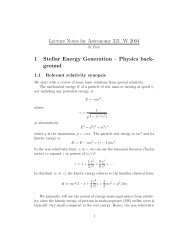Lecture Notes for Analog Electronics - The Electronic Universe ...
Lecture Notes for Analog Electronics - The Electronic Universe ...
Lecture Notes for Analog Electronics - The Electronic Universe ...
You also want an ePaper? Increase the reach of your titles
YUMPU automatically turns print PDFs into web optimized ePapers that Google loves.
<strong>The</strong> goal is to deduce VTH and RTH to yield the equivalent circuit shown in Fig. 5.<br />
V TH<br />
R TH<br />
Figure 5: <strong>The</strong> <strong>The</strong>venin equivalent circuit.<br />
To get VTH we are supposed to evaluate Vout when RL is not connected. This is just our<br />
voltage divider result:<br />
� �<br />
R2<br />
VTH = Vin<br />
R1 + R2<br />
Now, the short circuit gives, by Ohm’s Law, Vin = IshortR1. Solving <strong>for</strong> Ishort and combining<br />
with the VTH result gives<br />
RTH = VTH/Ishort = R1R2<br />
R1 + R2<br />
Note that this is the equivalent parallel resistance of R1 and R2.<br />
This concept turns out to be very useful, especially when different circuits are connected<br />
together, and is very closely related to the concepts of input and output impedance (or<br />
resistance), as we shall see.<br />
4<br />
R L













